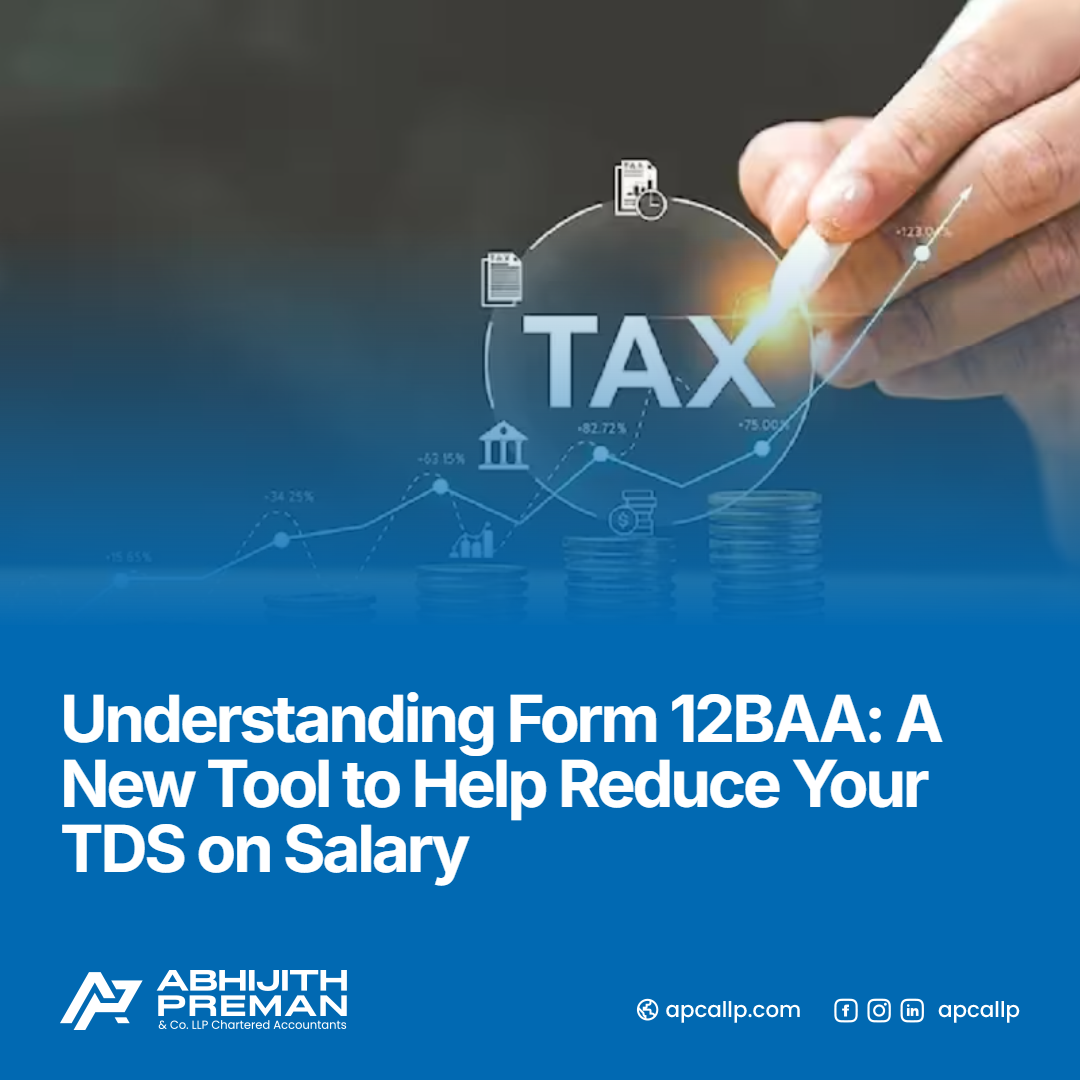
The Central Board of Direct Taxes (CBDT) recently introduced Form 12BAA, a new document allowing employees to communicate certain tax details to their employers. This step aims to reduce the Tax Deducted at Source (TDS) on salaries by accounting for other taxes employees have already paid. In this blog, we'll walk through what Form 12BAA is, how it works, and why it could be beneficial for salaried individuals seeking to minimize their tax outflows.
What is Form 12BAA?
Form 12BAA is a form introduced by the CBDT to allow employees to declare additional taxes paid beyond those covered by regular income tax provisions. This new form, effective from the financial year 2023-24, allows employees to inform their employers about specific types of taxes they have already paid. With this information, employers can adjust the TDS on salary accordingly, potentially leading to lower tax deductions each month.
This adjustment can especially benefit individuals who have paid advance taxes, self-assessment taxes, or other liabilities that impact their overall tax liability. Through Form 12BAA, the employer can consider these payments when calculating the monthly TDS on an employee's salary, ensuring that the employee doesn’t face excessive tax deductions at source.
Why Form 12BAA was Introduced?
The CBDT introduced Form 12BAA to address a common issue salaried individuals face: paying excess TDS on their salaries. Typically, TDS is deducted based on projected annual income without considering other taxes the individual may have already paid. This often results in individuals having to claim refunds at the end of the financial year, which can be inconvenient.
Form 12BAA allows for a more accurate and efficient TDS calculation process. By informing employers of additional taxes paid, employees can avoid the situation of excessive TDS deductions and reduce the need for tax refunds later.
Key Details of Form 12BAA
1. Scope of Taxes Covered: Form 12BAA covers advance tax payments, self-assessment taxes, and other specified taxes. These taxes are usually paid on income from other sources or additional income that the employee may have received. By including these in the calculation, employers can reduce the overall TDS on salary income.
2. Documentation: When submitting Form 12BAA, employees must attach proof of the taxes paid. This documentation is crucial, as it allows employers to verify the authenticity of the claims. Common documents include challans or receipts from the income tax department showing the amount paid, date, and type of tax.
3. Frequency and Deadline: Employees should ideally submit Form 12BAA at the beginning of the financial year or at any time during the year when additional taxes are paid. Prompt submission helps employers adjust the TDS calculations in a timely manner, ensuring smoother salary payouts.
4. Verification Process: Employers are required to verify the information provided in Form 12BAA. While this adds an administrative step, it ensures accuracy and helps employers correctly compute the revised TDS amount.
How to Submit Form 12BAA
To submit Form 12BAA, employees can follow these steps:
1. Download Form: Form 12BAA is available on the official Income Tax Department website.
2. Fill Out Details: Complete the form with accurate details, including information on the taxes paid and attach relevant documentation.
3. Submit to Employer: Submit the completed form and supporting documents to the employer’s payroll or finance department.
4. Follow Up: Ensure that the employer acknowledges the form and makes the necessary adjustments to your TDS calculation.
Benefits of Using Form 12BAA
Using Form 12BAA offers several benefits to employees:
1. Reduced TDS on Salary: By factoring in other taxes paid, Form 12BAA enables employers to deduct a lower TDS, leading to increased take-home pay each month.
2. Lower Refund Hassles: Many salaried employees face the hassle of waiting for refunds due to excessive TDS deductions. Form 12BAA can help reduce this issue by ensuring accurate TDS deductions aligned with the individual's actual tax liability.
3. Efficient Cash Flow Management: A reduced TDS each month enhances cash flow, which can be beneficial for managing monthly expenses and investments.
Points to Remember:
While Form 12BAA can help reduce monthly TDS, employees should be cautious about overestimating the taxes paid. Providing inaccurate or exaggerated information could lead to discrepancies in tax returns, potentially inviting scrutiny from tax authorities. It's also important to retain records of all payments and disclosures to ensure compliance and facilitate verification by the employer.
Conclusion
Form 12BAA represents a welcome move by the CBDT, empowering employees to take control of their monthly tax deductions. By factoring in taxes already paid, salaried individuals can avoid excessive TDS deductions and manage their cash flows more effectively. For those who regularly pay additional taxes, submitting Form 12BAA could make a significant difference in take-home pay and minimize tax refund issues at the year-end.
